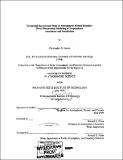Terrestrial sources and sinks of atmospheric methyl bromide : three-dimensional modeling of tropospheric abundance and sensitivities
Author(s)
Jensen, Christopher D. (Christopher David), 1974-
DownloadFull printable version (8.350Mb)
Alternative title
Terrestrial fluxes of atmospheric methyl bromide : three-dimensional modeling of tropospheric abundance and sensitivities
Other Contributors
Massachusetts Institute of Technology. Dept. of Earth, Atmospheric, and Planetary Sciences.
Advisor
Ronald G. Prinn.
Terms of use
Metadata
Show full item recordAbstract
Current estimates of methyl bromide surface fluxes are inconsistent with the observed tropospheric mole fractions (9 to 10 ppt, globally averaged) and the calculated atmospheric lifetime (1.7 ± 0.2 years), with mid-range estimates of sinks exceeding sources by at least 50 Gg y-I. Given the uncertainties in process-specific surface flux estimates, we consider several distributions of terrestrial sources and sinks that satisfy the constraints on atmospheric abundance, Mole fractions corresponding to each distribution are simulated with a three-dimensional chemical transport model based on analyzed observed winds, coupled to a simple model of the ocean mixed layer. All of the resulting scenarios overestimate the observed zonal gradient, with interhemispheric ratios ranging from 1.39 to 1.60. In the absence of unknown sources, model results imply a biomass burning source near the upper limit of the range of present estimates (50 Gg y-1). Sensitivities to surface fluxes are also calculated to determine the extent to which uncertain terms in the methyl bromide budget can be better quantified using long-term measurements. Results show that a global network capable of accurately monitoring the monthly, zonal mean distribution of CH3Br would be able to distinguish between biomass burning fluxes and other known terrestrial sources and sinks. Modeled sensitivities to biomass burning emissions also highlight the importance of including tropical locations in any long-term monitoring network. However, technological sources and soil sinks have similar zonal patterns, and long-term, "background" mole fractions are relatively insensitive to zonal flux distributions. It is only when we examine the high frequency variability of the concentration that the effect of longitudinal gradients in the flux field becomes apparent.
Description
Thesis (S.M.)--Massachusetts Institute of Technology, Dept. of Earth, Atmospheric, and Planetary Sciences, 1999. Includes bibliographical references (p. 87-92).
Date issued
1999Department
Massachusetts Institute of Technology. Department of Earth, Atmospheric, and Planetary SciencesPublisher
Massachusetts Institute of Technology
Keywords
Earth, Atmospheric, and Planetary Sciences.